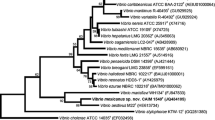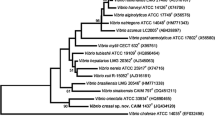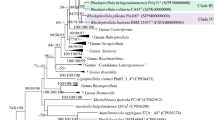Abstract
The first genomic study of Mediterranei clade using five type strains (V. mediterranei, V. maritimus, V. variabilis, V. thalassae, and V. barjaei) and fourteen reference strains isolated from marine organisms, seawater, water and sediments of the sea was performed. These bacterial strains were characterised by means of a polyphasic approach comprising 16S rRNA gene, multilocus sequence analysis (MLSA) of 139 single-copy genes, the DNA G + C content, ANI, and in silico phenotypic characterisation. We found that the species of the Mediterranei clade formed two separate clusters based in 16S rRNA gene sequence similarity, MLSA, OrthoANI, and Codon and Amino Acid usage. The Mediterranei clade species showed values between 76 and 95% for ANIb, 84 and 95% for ANIm. The core genome consisted of 2057 gene families and the pan-genome of 13,094 gene families. Based on the genomic analyses performed, the Mediterranei clade can be divided in two clusters, one with the strains of V. maritimus, V. variabilis and two potential new species, and the other cluster with the strains of V. mediterranei, V. thalassae, and V. barjaei.



Similar content being viewed by others
Abbreviations
- ANI:
-
Average nucleotide identity
- MLSA:
-
Multilocus sequence analysis
References
Amaral GRS, Dias GM, Wellington-Oguri M, Chimetto L, Campeão ME, Thompson FL, Thompson CC (2014) Genotype to phenotype: identification of diagnostic vibrio phenotypes using whole genome sequences. Int J Syst Evol Microbiol 64:357–365
Aziz RK, Bartels D, Best AA, DeJongh M, Disz T, Edwards RA, Formsma K, Gerdes S, Glass EM, Kubal M, Meyer F, Olsen GJ, Olson R, Osterman AL, Overbeek RA, McNeil LK, Paarmann D, Paczian T, Parrello B, Pusch GD, Reich C, Stevens R, Vassieva O, Vonstein V, Wilke A, Zagnitko O (2008) The RAST server: rapid annotations using subsystems technology. BMC Genom 9:75
Berger SA (2005) GIDEON: a comprehensive web-based resource for geographic medicine. Int J Health Geogr 4:10
Campbell BJ, Yu L, Heidelberg JF, Kirchman DL (2011) Activity of abundant and rare bacteria in a coastal ocean. Proc Natl Acad Sci USA 108(31):12776–12781
Chimetto LA, Cleenwerck I, Moreira APB, Brocchi M, Willems A, De Vos P, Thompson FL (2011) Vibrio variabilis sp. nov. and Vibrio maritimus sp. nov., isolated from Palythoa caribaeorum. Int J Syst Evol Microbiol 61:3009–3015
Chun J, Oren A, Ventosa A, Christensen H, Arahal DR, da Costa MS, Rooney AP, Yi H, Xu XW, De Meyer S, Trujillo ME (2018) Proposed minimal standards for the use of genome data for the taxonomy of prokaryotes. Int J Syst Evol Microbiol 68:461–466
Colwell RR (1970) Polyphasic taxonomy of the genus vibrio: numerical taxonomy of Vibrio cholerae, Vibrio parahaemolyticus, and related Vibrio species. J Bacteriol 104:410–433
Delmont TO, Quince C, Shaiber A, Esen ÖC, Lee STM, Rappé MS, McLellan SL, Lücker S, Eren M (2018) Nitrogen-fixing populations of Planctomycetes and Proteobacteria are abundant in surface ocean metagenomes. Nat Microbiol 3:804–813
Dubert J, Balboa S, Regueira M, González-Castillo A, Gómez-Gil B, Romalde JL (2016) Vibrio barjaei sp. nov., a new species of the Mediterranei clade isolated in a shellfish hatchery. Syst Appl Microbiol 39:553–556
Eren AM, Esen OC, Quince C, Vinies JH, Morrison HG, Sogin ML (2015) Anvi’o: an advanced analysis and visualization platform for ‘omics data. PeerJ 3:e1319
González-Castillo A, Enciso-Ibarra J, Bolán-Mejia MC, Balboa S, Lasa A, Romalde JL, Cabanillas-Beltrán H, Gomez-Gil B (2015) Vibrio mexicanus sp. nov., isolated from a cultured oyster Crassostrea corteziensis. Antonie Van Leeuwenhoek 108:355–364
Huson DH, Bryant D (2006) Application of phylogenetic networks in evolutionary studies. Mol Biol Evol 23:254–267
Hyatt D, Chen GL, Locascio PF, Land ML, Larimer FW, Hauser LJ (2010) Prodigal: prokaryotic gene recognition and translation initiation site identification. BMC Bioinform 11:119
Kim OS, Cho YJ, Lee K, Yoon SH, Kim M, Na H, Park SC, Jeon YS, Lee JH, Yi H, Won S, Chun J (2012) Introducing EzTaxon-e: a prokaryotic 16S rRNA Gene sequence database with phylotypes that represent uncultured specie0073. Int J Syst Evol Microbiol 62:716–721
Kushmaro A, Banin E, Loya Y, Stackebrandt E, Rosenberg E (2001) Vibrio shiloi sp. nov., the causative agent of bleaching of the coral Oculina patagonica. Int J Syst Evol Microbiol 51:1383–1388
Lagesen K, Hallin P, Rødland EA, Staerfeldt HH, Rognes T, Ussery D (2007) RNAmmer: consistent and rapid annotation of ribosomal RNA genes. Nucleic Acids Res 35:3100–3108
Lee I, Kim YO, Park SC, Chun J (2015) OrthoANI: an improved algorithm and software for calculating average nucleotide identity. Int J Syst Evol Microbiol 66:1100–1103
Lin H, Yu M, Wang X, Zhang X-H (2018) Comparative genomic analysis reveals the evolution and environmental adaptation strategies of vibrios. BMC Genom 19:135. https://doi.org/10.1186/s12864-018-4531-2
Meier-Kolthoff JP, Alexander AF, Hans-Peter K, Markus K (2013) Genome sequence-based species delimitation with confidence intervals and improved distance functions. BMC Bioinform 14:60
Moreira AP, Duytschaever G, Chimetto TLA, Dias GM, Mesquita M, Cnockaert M, Francini-Filho RB, De Vos P, Thompson CC, Thompson FL (2014) Vibrio madracius sp. nov. Isolated from Madracis decactis (Scleractinia) in St Peter & St Paul Archipelago, Mid-Atlantic Ridge, Brazil. Curr Microbiol 69:405–411
Noguerola I, Blanch AR (2008) Identification of Vibrio spp. with a set of dichotomous keys. J Appl Microbiol 105:175–185
Pascual J, Macián MC, Arahal DR, Garay E, Pujalte MJ (2010) Multilocus sequence analysis of the central clade of the genus Vibrio by using the 16S rRNA, recA, pyrH, rpoD, gyrB, rctB and toxR genes. Int J Syst Evol Microbiol 60:154–165
Pujalte MJ, Garay E (1986) Proposal of Vibrio mediterranei sp. nov.: a new marine member of the genus: Vibrio. Int J Syst Bacteriol 36:278–281
Quail MA, Smith M, Coupland P, Otto TD, Harris SR, Connor TR, Bertoni A, Swerdlow HP, Gu Y (2012) A tale of three next generation sequencing platforms: comparison of Ion Torrent, Pacific Biosciences and Illumina MiSeq sequencers. BMC Genom 13:341
Richter M, Rosselló-Móra R (2009) Shifting the genomic gold standard for the prokaryotic species definition. Proc Natl Acad Sci 106:19126–19131
Rosselló-Mora R, Amann R (2001) The species concept for prokaryotes. FEMS Microbiol Rev 25:39–67
Saitou N, Nei M (1987) The neighbor-joining method: a new method for reconstructing phylogenetic trees. Mol Biol Evol 4:406–425
Sawabe T, Ogura Y, Matsumura Y, Feng G, Rohul Amin AR, Mino S, Nakagawa S, Sawabe T, Kumar R, Fukui Y, Satomi M, Matsushima R, Thompson FL, Gomez-Gil B, Christen R, Maruyama F, Kurokawa K, Hayashi T (2013) Updating the Vibrio clades defined by multilocus sequence phylogeny: proposal of eight new clades, and the description of Vibrio tritonius sp. nov. Front Microbiol 4:414
Tamura K, Peterson D, Peterson N, Stecher G, Nei M, Kumar S (2011) MEGA5: molecular evolutionary genetics analysis using maximum likelihood, evolutionary distance, and maximum parsimony methods. Mol Biol Evol 28:2731–2739
Tarazona E, Lucena T, Arahal DR, Macián MC, Ruvira MA, Pujalte MJ (2014) Multilocus sequence analysis of putative Vibrio mediterranei strains and description of Vibrio thalassae sp. nov. Syst Appl Microbiol 37:320–328
Thompson FL, Hoste B, Thompson CC, Huys G, Swings J (2001) The coral bleaching Vibrio shiloi Kushmaro et al. 2001 is a Later Synonym of Vibrio mediterranei Pujalte and Garay 1986. Syst Appl Microbiol 24:516–519
Vesth T, Wassenaar TM, Hallin PF, Snipen L, Lagesen K, Ussery DW (2010) On the origins of a Vibrio species. Microb Ecol 59:1–13
Vesth T, Lagesen K, Acar Ö, Ussery D (2013) CMG-biotools, a free workbench for basic comparative microbial genomics. PLoS ONE 8(4):e60120
Weimann A, Mooren K, Frank J, Pope PB, Bremges A, McHardy AC (2016) From genomes to phenotypes: traitar, the microbial trait analyzer. mSystem 1(6):e00101-16
Acknowledgements
This work was partially funded by CONACYT Project CB-2009-01 132328. We thank P. David Vega-García and M. Carmen Bolán for technical help.
Author information
Authors and Affiliations
Corresponding author
Ethics declarations
Conflict of interest
The authors declare that they have no conflict of interest.
Additional information
Publisher's Note
Springer Nature remains neutral with regard to jurisdictional claims in published maps and institutional affiliations.
Electronic supplementary material
Below is the link to the electronic supplementary material.
Rights and permissions
About this article
Cite this article
González-Castillo, A., Enciso-Ibarra, J. & Gomez-Gil, B. Genomic taxonomy of the Mediterranei clade of the genus Vibrio (Gammaproteobacteria). Antonie van Leeuwenhoek 113, 851–859 (2020). https://doi.org/10.1007/s10482-020-01396-4
Received:
Accepted:
Published:
Issue Date:
DOI: https://doi.org/10.1007/s10482-020-01396-4




